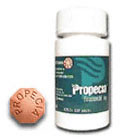
If you are going bald you may consider using Propecia to halt or even reverse your hair loss. While there is no “Hair Loss Cure”, Propecia (generic name finasteride) can often stop or even reverse alopecia in most men
Important – Women who may become pregnant should NOT take Propecia due to the risk of developmental defects in a male fetus
Studies have shown that almost 90% of men treat with Propecia (finasteride) stopped or even reversed their hair loss to some degree over the course of five years. The active ingredient - finasteride effectively reverses miniaturization but will not grow hair in completely bald areas.
Propecia (Finasteride) was originally a drug called Proscar, which was used to treat and reduce men’s prostate conditions such as benign prostatic hyperplasia (BPH).
Its parent company, Merck & Co., soon realized that the drug had a unique side effect - it grew hair on bald men's heads. In December 22, 1997 the FDA approved Propecia as a hair loss pill. Merck & Co. then marketed the drug as a hair loss treatment under the trade name of Propecia.
How Propecia inhibits DHT and hair loss.
Baldness is largely the result of dihydrotestosterone (DHT) interacting with those hair follicles that are genetically vulnerable to their effects.
DHT is essentially the active ingredient or catalyst for the hair loss process. DHT binds with the receptor sites of genetically vulnerable follicles and gradually degrades the follicles ability to produce healthy hair. This eventually results in baldness in the affected areas.
Propecia works by inhibiting the conversion of testosterone into "DHT". By reducing the DHT present in the scalp the thinning process is slowed and sometimes even reversed.
Limitations of Propecia.
However, Propecia has not been proven to restore hair in the frontal areas. For reasons yet unknown these drugs, along with Rogaine, generally only work in regrowing thinning hair in crown area of the scalp.
Only hair transplant surgery has been successful in restoring hair in the frontal hairline area once it has been lost. Propecia is also less effective in growing hair in older men. These hair loss drugs work best for men who have been balding for less than five years.
Side Effects of Propecia (finasteride) – Temporary and Permanent
Given that Propecia (finasteride) was granted FDA approval as a hair loss treatment in 1997, both studies and actual patient experiences have revealed that Propecia can result in side effects, both temporary and permanent, such as decreased libido, erectile dysfunction, and decreased semen.
Prior to the FDA approval of Propecia as a hair loss treatment, Merck – the maker of Propecia (finasteride) reported in their phase III clinical trial side effects including decreased libido, erectile dysfunction, and decreased semen.
In the Propecia group, 1.8 % of the participants suffered from reduced libido instead of 1.3% in the placebo group. 1.3% had difficulty achieving an erection in the Propecia group vs. 0.7% in the placebo group. Around 0.8% of men in the Propecia group experienced a decrease in semen vs. 0.4% in the placebo group.
This official trial conducted before 1997 stated the side effects resolved once men discontinued the medication. However, since that time many users of Propecia have reported significant side effects exceeding the amount that would be expected based on the phase III study. Many also reported that the side effects did not go away after they stopped using Propecia (finasteride). This has come to be known as “Post Finasteride Syndrome”.
Post-Finasteride Syndrome - Persistent Side Effects
Many men have reported persistent side effects years after stopping the drug and thousands of men have filed lawsuits because ongoing side effects were not mentioned on the label.& As a result, in 2012, the FDA mandated a label change. The label now lists " libido disorders, erectile dysfunction, and orgasm disorders after discontinuation of the drug."
Many websites promoting finasteride claim there are no studies or scientific evidence to back post-finasteride syndrome (PFS). However, persistent side effects were not reported in the initial Merck funded Propecia trials, which Reuters discovered through redacted court documents in a 2019 article.
Furthermore, in a 2017 study conducted by Northwestern Medicine, out of 11,909 men studied, 167 (1.4%) developed persistent erectile dysfunction, which persisted a median of 1,348 days (almost four years) after stopping the drug. According to an article by Reuters posted in 2019, they uncovered that court records intentionally withheld information from the public about persistent side effects. For more information regarding post-finasteride syndrome, visit https://www.pfsfoundation.org/.
Propecia (finasteride) Alternative Options
Given concerns about the side effects stemming from ingesting Propecia orally, many hair loss sufferers have chosen to apply finasteride, and a similar and arguably more effective compound known as Dutasteride, topically on their scalp to avoid ingesting it into their bodies orally. Sometimes this topical treatment is combined with minoxidil (Rogaine) and other topical hair loss treatments for maximum efficacy.
Many claim that this topical treatment is more effective than oral Propecia (finasteride) and has fewer side effects.
Review Actual Patient Experiences with Propecia
For in-depth discussion of the pros and cons of Propecia from actual patients visit our hair restoration discussion forum and search for Propecia and or post finasteride syndrome.
Get a Prescription for Propecia.
Most of the physicians recommended on this site will prescribe Propecia to halt a patient’s hair loss and then restore the hair already lost with hair transplant surgery. These treatments in combination can work synergistically. The drugs work to halt the hair loss, while hair restoration surgery restores what was lost..
Consult with a quality physician to get a prescription for Propecia.







